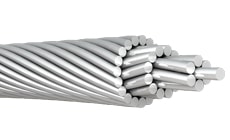
Description:
Consisting of one or more strands of 1350 aluminum alloy wire, AAC is a flexible and relatively lightweight conductor. Compared to the similar ACSR, a steel reinforced aluminum conductor, this conductor provides more versatility and mobility while ACSR provides a higher level of conductor strength.
Applications:
It can be used in low and medium voltage overhead lines. It’s commonly used in urban areas because of its ability to carry significant voltages over short distances. The long-lasting, corrosion resistant qualities of aluminum make this conductor a popular choice for use in coastal areas as well as for use in the railway and subway industries. Shipyards and offshore construction sites benefit from the conductor’s durability. This conductor can be used for most overhead transmission duties when conductor strength is not a factor. The conductor can also be used for primary and secondary distribution applications.
Specifications:
All Aluminum Conductor meets or exceeds the specifications set forth by the American Society for Testing and Materials:
• B-230 for Aluminum Wire and 1350-H19 grade aluminum for Electrical Purposes.
• B-231 standards, calculated by using the wire’s nominal diameter and minimum average strength for Aluminum Conductors and Concentric-Lay-Stranded categories.
Construction:
• Conductors - AAC is constructed of one or more aluminum alloy 1350-H19 wires. Bare EC grade strands are hard drawn wrapped around a central wire.
• Stranding - Helically stranded.
| Technical Specifications: | |
| Size AWG: | 2500 |
| Stranding: | 91 |
| Stranding Class: | A |
| Diameter Individual Wire Aluminum (Inches): | 0.1657 |
| Diameter Complete Cable (O.D.) (Inches): | 1.823 |
| Cross Sectional Area (Sq. Inches): | 1.964 |
| Weight Per 1000ft Total (Lbs.): | 2370 |
| Rated Breaking Strength (Lbs.): | 41900 |
| Resistance DC 20°C Per 1000ft: | 0.00698 ? |
| Resistance DC 75°C Per 1000ft: | 0.00969 ? |
| Allowable Ampacity 90C (Amps): | 1706 Amps |
